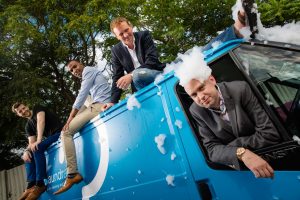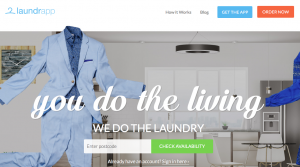The Founder and CEO of Laudrapp, Edward Relf (bottom right below), shared some great insights on brand building in a digital age at the Festival of Marketing. Laudrapp is an on-demand laundry platform that allows you to have your washing picked up, cleaned and dropped off. The fast growing company operates in 100+ towns and cities in the UK, with 15 international markets planned by 2018.

1. Use your gut, not jut data
With the explosion of data analytics, I worry that today’s younger marketers may miss out on building and honing their instinct about what will work and not. So it’s refreshing to hear a business leader sing the praises of using your gut as part of decision making.
“Don’t allow data to control every decision, as you will do what everyone else is doing and it can lead to inaction,” suggests Edward. “There is room for gut feel. You can test and learn if your instinct is right by creating an ‘MVP’ (minimum viable product).”
2. Test/Learn/Kill or Scale
Laundrapp’s ‘lean innovation process’ involved a cycle of ‘Test ->Learn ->Scale or Kill’, at speed. Testing took weeks rather than the months or even years it does in a some big companies. “90% of what you try may fail,” he warned. “But this is OK if you learn/test/scale or kill, at speed.”
Laundrapp worked on one stage of the purchase ‘funnel’ at a time during the ‘soft launch’ phase, with a limited number of customers. For example, checkpoint 1 was the % of app opens that converted to registration. The team refined the product to hit the KPI needed to deliver the business plan, before moving on to the next stage of the funnel, such as the % of people registering who made a first purchase.
Other interesting learning from the test phase included:
- When: busiest time for orders was expected to be weekend evenings, but turned out to be 7am on Monday morning. This led to a change in marketing strategy to target Monday morning, convenience seeking commuters
- Who: the hypothesis was that, of course, Millennials would be the biggest users. However, they lack the spare cash of older people, who are now the core target!
3. Its about the product stupid
“You can have all the data you want, but it won’t help you if you don’t get the service right,” warned Edward. He and his team are working on “creating a flawless customer journey”, mapping out and refining each stage of the experience.
Some of the customer experience enhancements include:
- Personalisation: profiling people as they come on to the service, to personalise their experience e.g. being contacted by phone call versus email
- Simplicity: making “onboarding” quick and easy have been critical to drive sales. For example, being able to make your first order before creating an account, not after, has driven much better conversion and bigger bigger basket size
- Expansion: Laundrapp learnt that the best way to expand into new cities was not by data crunching, but by encouraging demand. If you enter your post code and Laundrapp is not in your area, you can launch a vote for it to come. This means that when Laundrapp does arrive, there is a ready-made customer base!

4. Follow the money, don’t count followers
There was a welcome reminder from Edward to ignore “vanity metrics” such as Facebook followers and YouTube views. Laundrapp use three key measures that are all linked to selling more stuff. All marketing activity needed to drive one of these measures:
- Sell: place first order
- Convert: placing a second order is key to change the consumer habit
- Keep: become a regular customer
Another simple measure used is to get a 3 x payback versus the cost per acquisition (CPA) in three years.
5. Focus your channels (and don’t forget TV!)
With the proliferation of media channels today, it is easy for marketing teams to feel the need to try every channel out there. Edward recommends you focus and find three channels that really work.
He also reminds teams not to forget traditional channels. “TV advertising works really well to drive traffic to the site. Digital display for re-targeting helps drive site visitors to download the app,” he explained.
Edward also highlighted how to use a multi-channel strategy to follow customer habits. Mobile ads work well during a morning and evening commutes, whereas desktop is better for targeting people at work during the day.
In conclusion, Edward’s approach at Laudrapp is a great example of rebooting marketing for a digital age. He is following the money, really understanding customer needs, developing a great product “sausage” and blending the best of traditional and new media.
